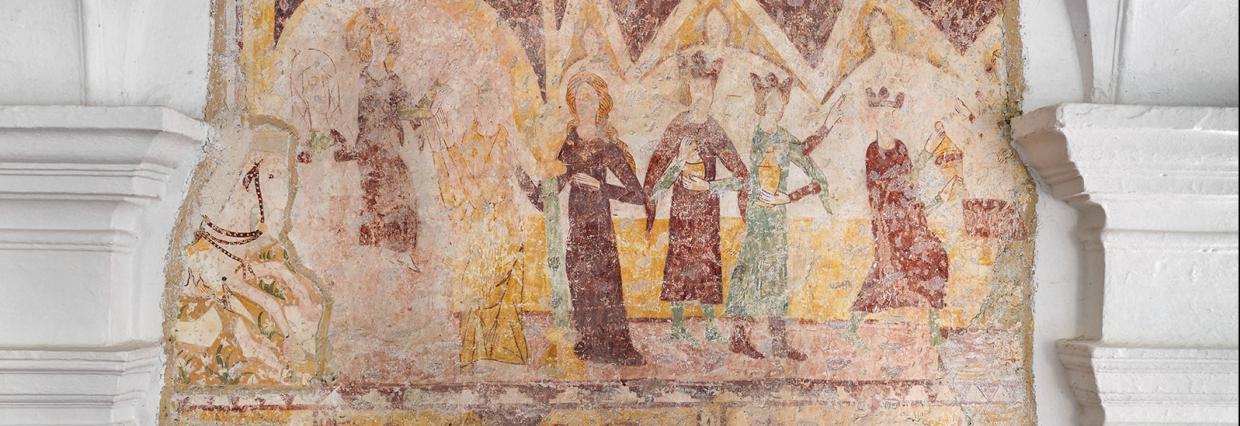
Corpus picturarum muralium medii aevi
Corpus picturarum muralium medii aevi (online, 1–2 September 2022)
An international Zoom conference organised by the Scientific Research Centre of the Slovenian Academy of Sciences and Arts (ZRC SAZU) and the Faculty of Arts, University of Ljubljana, 1–2 September 2022
Deadline: 30 April 2022
CFP_CORPUS_PICTORARUM_2022_0.pdf
Since 1 September 2020, the Scientific Research Centre of the Slovenian Academy of Sciences and Arts (ZRC SAZU) has led the research project titled Transformations – from Material to Virtual. Digital Corpus of Mural Painting – New Dimensions of Medieval Art Research in Slovenia. The project partner is the Faculty of Arts of the University of Ljubljana. The project’s main goal is to set up an online scientific corpus of medieval mural painting in Slovenia with the universal title Corpus picturarum muralium medii aevi. Within this project, we are developing a corpus of mural paintings in Slovenia until circa 1380, which will be expanded with further projects to include paintings until around 1500. Another project objective is to organise an international conference on medieval mural painting at the transition between the Romanesque and Gothic style, the creation of medieval art heritage corpora, and various aspects of medieval art analysis with an international discussion about the establishment of the joint international database Corpus picturarum muralium medii aevi.
The transition between the first two universal European art periods – the Romanesque and the Gothic – has been a major research topic for a long time. Nevertheless, this transition still represents an enormous methodological challenge, even in the field of mural painting. Outside its homeland of France, the Gothic style asserted itself very gradually and through various paths, spreading throughout the rest of Europe and even beyond. The characteristics of this expansion can be gleaned precisely from the mural paintings dating back to this period – particularly in the case of buildings that would later be heavily reconstructed and whose movable furnishings (table paintings, altars, manuscripts, reliquaries, etc.) have been long lost. Especially the examples from Central Europe, featuring phenomena such as the zig-zag style and the often robust Romanesque tradition up to the 14th century, indicate that the process of the Gothic style reception was exceedingly complex. The medieval late Romanesque and (early) Gothic mural painting thus calls for a constant questioning of the established hypotheses and a broadening of the methodological and increasingly also technological approaches – both in the fields of interpretation and discovery as well as conservation, restoration, and documentation. The advances in the field of digital humanities, in particular the creation of digital databases that facilitate the overview of such dispersed subjects, also play an increasingly important role in medieval mural painting research.
Therefore, the upcoming conference aims to open a discussion on the new approaches to the study of medieval mural painting and seek answers to questions such as: how do the discoveries of new paintings or the development of new approaches expand on the ideas about the iconographic and stylistic profile of mural painting between the Romanesque and the Gothic periods? To what extent do new technologies or their increased availability influence research? What has been the experience in creating and linking (digital) corpora of medieval art heritage? What is the significance of discovering, exhibiting, and reinterpreting medieval mural paintings in the broader political context of the 20th century in particular?
The proposed topics may include but are not necessarily limited to the following:
- new medieval mural painting research discoveries;
- spatial or visual references of medieval mural paintings to other art genres;
- new discoveries about the roles of artists, commissioners, and reception;
- comparative analyses with other periods and regions (the influences of Byzantine, Islamic, and other art);
- new technical methods for research, discovery, restoration, documentation, etc.;
- issues related to collecting, editing, and presenting research in the digital media;
- digital corpora of medieval wall paintings;
- new overviews and outlooks on the history of medieval mural painting research;
- reception of mural painting between the Romanesque and Gothic styles in the subsequent periods;
- broader socio-political analysis of mural paintings in the context of the 20th-century medieval art research.
We invite researchers at all stages of their careers to participate. Proposals for contributions in the English language and approximately 20 minutes long, consisting of a title and an abstract not exceeding 250 words, should be sent together with a short CV of no more than a single page to cfp.uifs@zrc-sazu.si, by 30 April 2022. The selection is expected to be completed by 30 June 2022.
Organisers:
Assistant Professor Dr Mija Oter Gorenčič, ZRC SAZU, France Stele Institute of Art History, Ljubljana, and Faculty of Arts, University of Maribor
Assistant Professor Dr Gašper Cerkovnik, Faculty of Arts, University of Ljubljana